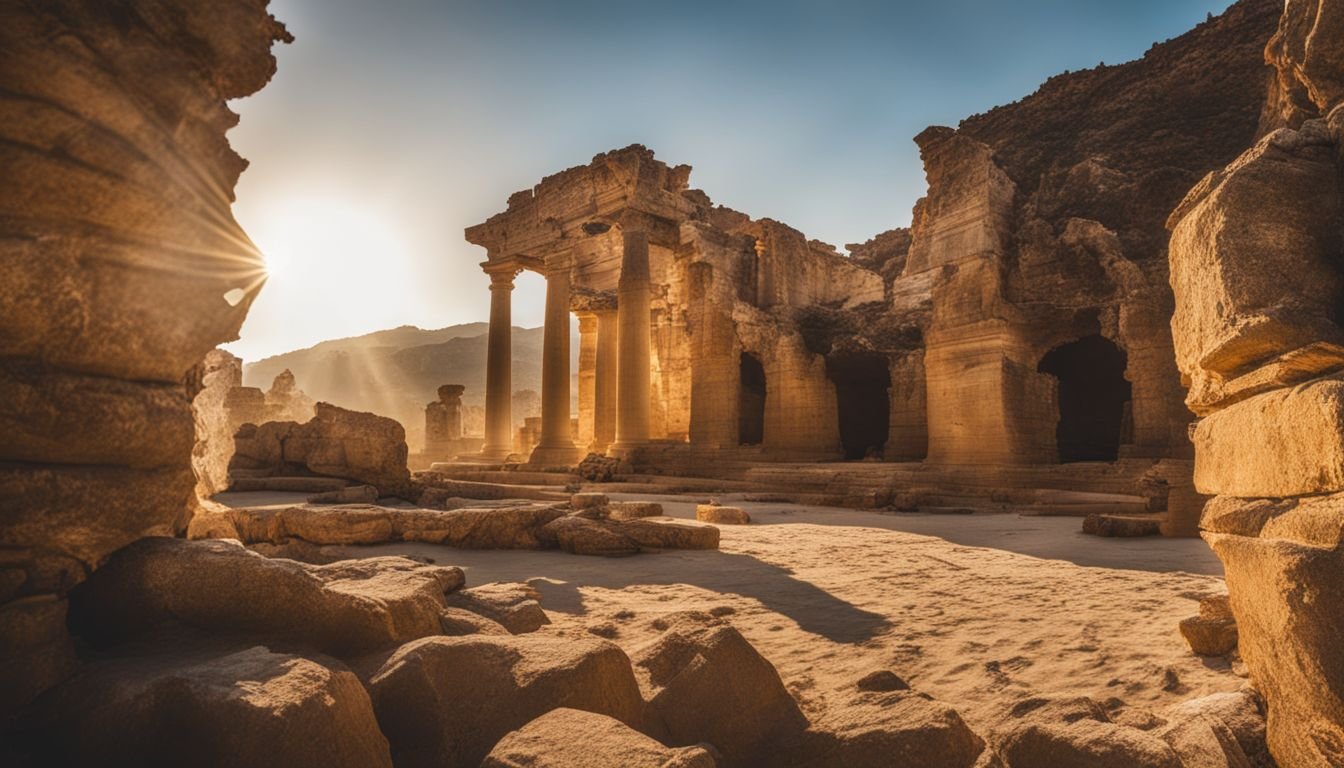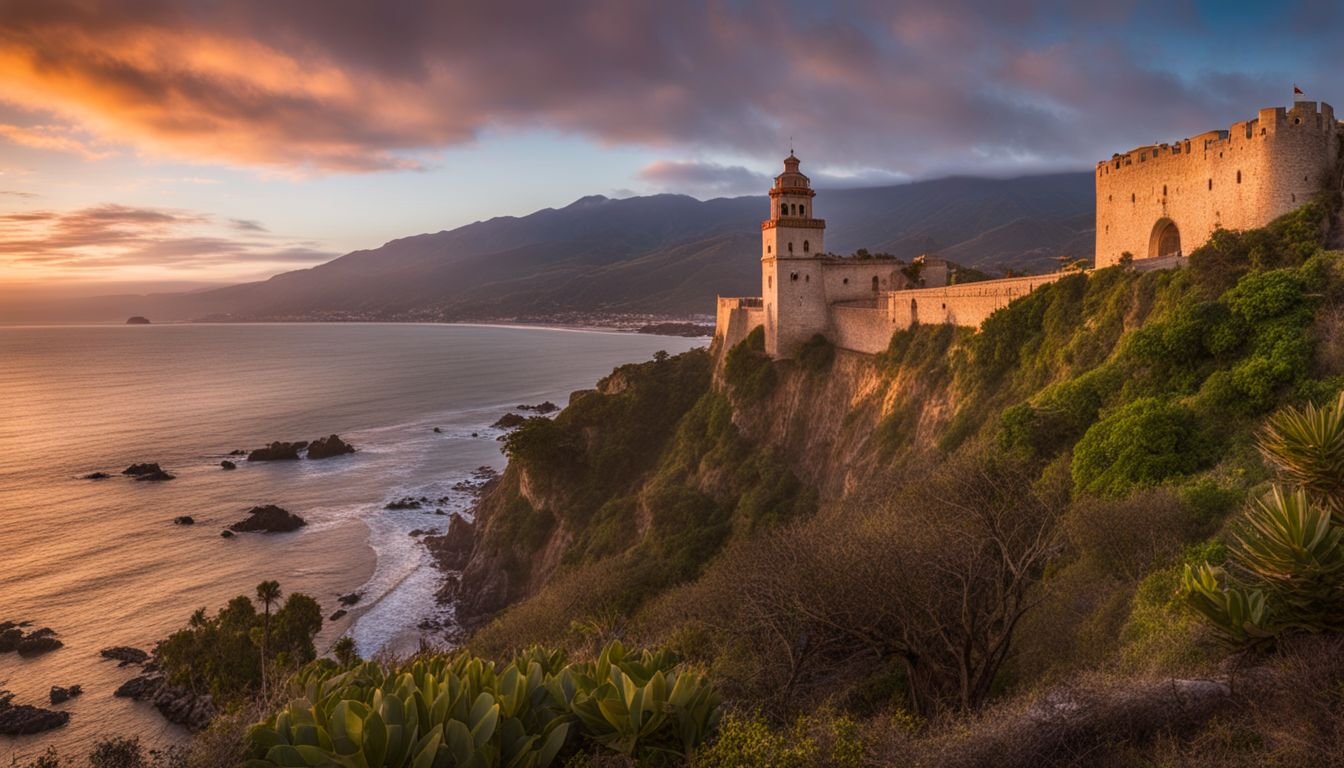Beaches with historical significance in Costa Blanca
Choosing the perfect beach can be tricky with so many options available. Costa Blanca is known for its stunning beaches that also hold tales from the past. This article will guide you through beaches in Costa Blanca where sunbathing meets history, offering more than just a typical day by the sea.
Get ready to explore!
Overview of Costa Blanca Beaches

Costa Blanca boasts several stunning beaches, including Playa de Levante, Platja de Ponent, Playa de San Juan, Playa de La Mata, and Playa La Granadella. These beaches offer pristine sands and azure waters that attract locals and tourists alike.
Playa de Levante
Playa de Levante shines as a beacon for tourists seeking the sun-kissed shores of the Costa Blanca region in Spain. Its golden sands stretch invitingly, offering unparalleled views of the Mediterranean Sea.
This beach is not just about relaxation; it’s a hub buzzing with energy from dawn till dusk. Hotels and resorts line its promenade, ensuring visitors have immediate access to both comfort and scenery.
Visitors flock to Playa de Levante for more than just its breathtaking vistas; they come for an array of tourist activities that promise adventure and leisure in equal measure. From water sports that get your heart racing to serene walks along the beach at sunset, this destination caters to all preferences.
The proximity to Benidorm’s old town adds a cultural spin to your beach holiday, letting you explore historic streets after a day under the Alicante sun.
Platja de Ponent
Platja de Ponent offers visitors an unparalleled beach experience. Families, couples, and budget travelers find this hidden gem in the Costa Blanca region perfect for relaxation. Its remarkable cleanliness and water quality stand out, making it a beloved spot for indulging in water sports or simply soaking up the serene atmosphere.
With a promenade lined with cafes, bars, and restaurants, guests can enjoy delicious meals while admiring stunning sea views.
Conveniently located near major transportation hubs such as Alicante Airport, accessing Platja de Ponent is hassle-free. Accommodation options nearby cater to all preferences, ensuring a comfortable stay for everyone who comes to explore its natural beauty and historical attractions.
The combination of tranquil surroundings and engaging activities makes Platja de Ponent a must-visit destination within the Province of Alicante.
Playa de San Juan
Moving from the serene vibes of Platja de Ponent, Playa de San Juan introduces visitors to a blend of historical charm and modern leisure. This popular beach, nestled in the Costa Blanca region, offers miles of golden sands flanked by crystal clear waters.
As a key tourist destination near Alicante city, it connects people not just to stunning natural beauty but to a rich tapestry of history and culture.
The area surrounding Playa de San Juan serves as a gateway to numerous attractions such as Castillo de Santa Barbara and El Casco Antiguo de Benidorm. It’s perfect for those who thrive on outdoor activities or simply wish to soak up the sun while delving into the region’s past.
With efficient transportation options including trams and buses, accessing this picturesque spot is hassle-free for those carrying hand luggage or seeking adventure in Alacant’s vibrant community.
Playa de La Mata
Playa de La Mata is a prominent beach in Costa Blanca known for its historical significance and picturesque scenery. The beach, with its clean and clear waters, attracts families and couples seeking a relaxing and enjoyable experience.
Visitors can easily access amenities such as cafes, bars, and restaurants to enhance their stay. Additionally, the area around Playa de La Mata provides various accommodation options, ensuring convenience for tourists looking to explore both the beach and its historical surroundings in detail.
Playa La Granadella
Playa La Granadella boasts a rich historical significance, drawing in visitors intrigued by the area’s heritage. The beach provides a tranquil and captivating setting for relaxation and exploration of the region’s historical importance.
Visitors can also take the opportunity to discover nearby historical sites and cultural attractions while immersing themselves in the allure of Playa La Granadella.
Keyword: hidden gems, romantic places, valencian community
Significant Historical Landmarks on Costa Blanca Beaches

Explore the Castillo de Santa Barbara, perched high on Mount Benacantil, offering stunning panoramic views and a rich history dating back to the 9th century. Witness El Casco Antiguo de Benidorm with its charming old town and picturesque blue-domed church, an emblem of traditional coastal architecture.
Castillo de Santa Barbara
Perched on a rocky outcrop overlooking Alicante, Castillo de Santa Barbara offers sweeping panoramic vistas of the city and its coastline. This imposing fortress stands as a testament to the region’s rich history and is a significant historical landmark on Costa Blanca.
Visitors can immerse themselves in the castle’s storied past by exploring its well-preserved grounds and learning about the pivotal role it played in shaping the area’s heritage. With its commanding presence and intriguing historical significance, this iconic castle promises an enriching experience for those seeking deeper insights into the cultural tapestry of Costa Blanca.
Alicante has long been home to this popular tourist attraction, drawing visitors from near and far who are intrigued by its historical prominence. The castle presents an opportunity for guests to delve into Costa Blanca’s captivating legacy through tactile exploration, making it an essential stop for history enthusiasts seeking to uncover the region’s compelling past.
El Casco Antiguo de Benidorm
Perched high above the coast, El Casco Antiguo de Benidorm offers a captivating glimpse into the region’s rich history. With its narrow streets and picturesque whitewashed houses, this historic old town beckons visitors to explore its charming alleyways and discover hidden gems at every turn.
The area of Barrio Santa Cruz is particularly alluring, providing direct access to Santa Barbara Castle and offering breathtaking panoramic views of the coastline from Benidorm.
A must-visit for history enthusiasts, El Casco Antiguo de Benidorm stands as a testament to the enduring legacy of the region and provides an immersive experience that transports visitors back in time.
Guadalest Valley
After exploring the historical significance of El Casco Antiguo de Benidorm, another must-visit landmark in Costa Blanca is Guadalest Valley. This picturesque valley boasts a rich history and stunning natural beauty, making it an ideal destination for history enthusiasts and nature lovers alike.
Perched high up in the mountains, Guadalest Valley offers a glimpse into the region’s past with its historic castle, museums, and charming old town.
Travelers can access Guadalest Valley through various transportation options while enjoying accommodations at reputable hotels such as Magic Costa Blanca Hotels, B&B Hotels, Melia Hotels, among others.
Balcon del Mediterraneo
Balcon del Mediterraneo offers stunning panoramic views of Poniente and Levante Beaches in Costa Blanca. The viewpoint is a must-visit for history enthusiasts and beach lovers alike, providing a perfect vantage point to take in the majestic scenery.
Visitors can marvel at the expansive coastline while appreciating the historical significance of the area. It’s not just about the breathtaking beauty; Balcon del Mediterraneo allows visitors to experience the historical charm that permeates this remarkable region of Valencia.
Denia Castle and Archaeological Museum
Located near the Balcon del Mediterraneo, Denia Castle and Archaeological Museum stands as a significant historical landmark along the Costa Blanca beaches. Offering breathtaking views of the coast from its strategic perch in Denia, the castle provides visitors with a glimpse into the region’s rich past.
Exploring the archaeological museum within its walls unveils artifacts and exhibits that vividly depict the historical significance of this coastal area. For history enthusiasts seeking a blend of beachfront beauty and cultural exploration, Denia Castle and Archaeological Museum is a must-visit destination offering an enriching experience.
The archaeological museum at Denia Castle serves as an educational portal for understanding the diverse cultural tapestry that underpins this ever-evolving part of Spain. From ancient relics to meticulously curated displays, it invites visitors to delve into centuries-old tales while marveling at well-preserved historical treasures.
The Old Town and Iglesia Vieja of Calpe
Calpe’s Old Town is characterized by narrow stone streets, traditional homes, and a rich historical ambiance. Nestled at the heart of the town, it offers a glimpse into Calpe’s past and serves as an immersive experience for history enthusiasts.
The Iglesia Vieja, situated within the Old Town, stands as the only surviving example of Mudejar-Gothic architecture in Valencia. Its historical significance adds depth to the town’s cultural heritage and provides a captivating sight for visitors seeking both natural beauty and historical charm in Costa Blanca.
Banos de la Reina (Queen’s Baths) in Calpe
Banos de la Reina in Calpe is a historical site dating back to the 2nd and 4th centuries, showcasing ancient Roman ruins. These ruins are believed to have served as a fish farm and thermal baths during that era, signifying a glimpse into the architectural and cultural importance of the region.
The Banos de la Reina in Calpe offer visitors an opportunity to witness firsthand the historical legacy left by the Romans in this coastal area of Costa Blanca. With its intriguing combination of ancient fish farming structures and thermal baths, these remains provide insight into both daily life and technological advancements from centuries ago.
Historical Significance of Costa Blanca Beaches
Costa Blanca beaches boast significant historical value, with captivating architectural and archaeological treasures, cultural importance, and a rich tapestry of historical events that have shaped the region.
Discover the allure of these storied shores by reading on.
Historical Events
Historical events have shaped the beaches of Costa Blanca, leaving behind a rich tapestry of stories and experiences. From ancient Roman settlements to medieval fortresses, visitors can immerse themselves in the region’s diverse history.
The area has witnessed conquests, trade routes, and cultural exchanges over the centuries, making it a compelling destination for those intrigued by the past.
Not only do these historical events provide insight into the region’s past, but they also offer an opportunity for visitors to connect with the enduring legacies that continue to influence Costa Blanca today.
Architectural and Archaeological Value
Costa Blanca’s beaches hold significant architectural and archaeological value, with historical landmarks showcasing ancient ruins, religious sites, and impressive architectural buildings.
Visitors can explore the remains of Lucentum in El Campello, a significant archaeological site dating back to the Roman times. The imposing Denia Castle and Archaeological Museum also stand as a testament to the region’s rich history, offering insight into its past.
Furthermore, Santa Pola is home to the Tamarit Tower, a historic watchtower that served as a defense structure against pirate attacks during ancient times.
The region also boasts an array of architectural marvels such as Orihuela’s stunning Cathedral of Salvador and breathtaking Calpe’s Banos de la Reina (Queen’s Baths) – remnants from Roman occupation providing a glimpse into early civilizations.
Cultural Importance
Exploring the historical landmarks and architectural marvels on Costa Blanca beaches unveils their cultural importance. These sites offer a window into the region’s rich heritage, blending past and present to create an immersive experience for visitors.
From ancient ruins to religious sites, museums, and architectural wonders, each location contributes to preserving and celebrating the unique cultural tapestry of Costa Blanca. As visitors navigate through these significant landmarks, they not only witness the historical events but also gain insights into the ever-evolving realm of art, architecture, and local traditions.
The allure of Costa Blanca’s beaches lies in more than just sun and sand; it offers a transformative journey through history that highlights its deep-rooted cultural significance.
Visiting Costa Blanca Beaches
When planning a visit to Costa Blanca beaches, consider the best time to go and explore the area. Ensure a hassle-free journey by researching transportation options and beach facilities before your trip.
Best Time to Visit
The best time to visit Costa Blanca beaches is during the spring and summer months, between April and September. During this period, the weather is warm and sunny, ideal for enjoying the beautiful coastline and historical landmarks.
The region experiences a Mediterranean climate with long, hot summers and mild winters. It’s important to note that July and August are peak tourist months so visitors may encounter larger crowds during these times.
Travelers should also consider visiting in late spring or early autumn when temperatures are still pleasant but with fewer tourists. It’s advisable to plan visits outside of midday hours due to the intense heat typical of the summer months.
How to Get There
Once you’ve decided on the best time to visit Costa Blanca beaches, it’s essential to plan how to get there. The region offers various transportation options, including trams, ferries, taxis, buses, and rail services.
Many hotels in close proximity to popular landmarks and attractions make it easier for tourists to access the beaches with historical significance in Costa Blanca.
The automated tracking system facilitates ease of travel as visitors can quickly navigate through the different transport modes available in this ever-evolving region. It is advisable for travelers to explore shuttle service options as an efficient means of reaching their desired beach destinations hassle-free.
Beach Safety and Facilities in Costa Blanca
Costa Blanca beaches offer a range of facilities for visitors, including lifeguards, first aid services, and beach showers. Many of these stunning beaches have received Blue Flag certification for their high water quality and safety standards.
Additionally, visitors can find an array of amenities near the coastline in Costa Blanca, such as beachfront restaurants, cafes, and shops. These facilities ensure that visitors can enjoy a safe and comfortable experience while exploring the beautiful beaches in this picturesque region.
Visitors to Costa Blanca are encouraged to take advantage of the available facilities and adhere to beach safety guidelines provided by the designated authorities. It’s essential to stay informed about safety protocols and make use of the amenities offered at these breathtaking coastal destinations.
Conclusion
After exploring the beaches with historical significance in Costa Blanca, visitors can appreciate the blend of natural beauty and rich cultural heritage. The region offers a unique opportunity to engage with history while enjoying the sun, sand, and sea.
From ancient ruins to architectural marvels, these beaches provide a captivating experience for travelers seeking both relaxation and historical enrichment. With each beach telling its own story of the past, Costa Blanca is a destination where history comes alive amidst breathtaking coastal landscapes.
FAQs
1. What makes the beaches in Costa Blanca historically significant?
The beaches in Costa Blanca, like Dénia and Los Alcázares, are not just beautiful spots for sunbathing; they carry rich histories that reflect the diverse cultures and events that have shaped the region of Murcia and its surroundings over centuries.
2. Can you visit historical sites near the beaches in Costa Blanca?
Yes, many beaches in Costa Blanca are close to historical landmarks and ruins. Visitors often find themselves exploring ancient castles or archaeological sites after enjoying a day at the beach.
3. Are there community guidelines for visiting these historical beaches?
Visitors should follow community guidelines designed to protect and preserve these historical sites around Costa Blanca’s beaches. These rules help ensure that everyone can enjoy the beauty and history of these places without causing harm.
4. What should I bring when visiting historical beaches in Costa Blanca?
When planning a visit to these significant beaches, remember to pack your baggage with essentials like water, sunscreen, comfortable walking shoes for exploring nearby historical sites, and perhaps a guidebook on the region of Murcia to enhance your understanding of its heritage.







